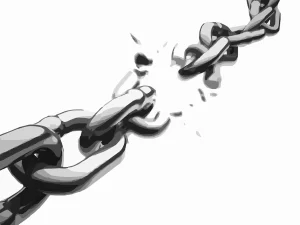A synopsis is what publishers use to decide what books they want to publish. If you are an author, this will help get your book published.
A synopsis should be between 1-2 single-spaced pages long. It should be written in the present tense and the third person. It should include the following: who the target audience for the book is, what problem it solves, what need does it fill? How does it do that? What’s at stake if things don’t work out?
In this blog post, you will learn the seven steps required to write an excellent synopsis for your thriller.
1. What is the protagonist’s goal, and how do they achieve it in the end?
Your synopsis needs to clarify the protagonist’s goal and what they must do to succeed.
Include what obstacles are standing in their way, what makes it difficult for them to achieve success, what kind of a struggle does our hero go through? How long have they been struggling with this problem? What other issues arise along the way that your protagonist must solve?
Here is an example:
Let’s call her Jennifer – she left an abusive relationship to start a new life with her own beauty salon business to support her. She has a troubled relationship with her parents, knows that she has to do something about it, and sets a goal to change her relationship values, both romantic and familial. Now she’s looking forward to a kayaking trip in the BC wilderness with a group of friends.
2. The setting of your story
The next element in your synopsis is the setting of your story.
What is the time period?
From August to September 2018.
Where does it take place?
It takes place in and around Vancouver, the city of Richmond, the interior of central BC, and in Bowron Lake Park, BC.
What type of places are there?
The protagonist has an apartment in the affluent Kitsilano area of Vancouver.
Bowron Lake Park is a popular wilderness area at the foot of the Cariboo Mountains, 800 K north of Vancouver.
The antagonist hides in a derelict old hunting cabin in a secluded part of British Columbia.
The protagonist is abducted and held in a small house in a low-income neighborhood in Richmond city.
3. A description of the antagonist or villain
Once you have defined the protagonist and the setting, it’s time to focus on what makes them struggle. Who is their enemy? What kind of a person or entity is causing trouble for your protagonist?
You must describe what type of villain it is, what they look like, and what kind of personality this individual has? What methods do they use to try and defeat the protagonist?
-The villain is a tall, good-looking white man with dark, longish hair tied in a ponytail. He dresses in black leather from top to toe. He can be utterly charming when he wants to or manipulating, intimidating, and dangerous when things don’t go his way.
Here is an example:
When Jennifer first meets the villain, a well-dressed, good-looking man enters her beauty salon asking if he could have a haircut without an appointment. He makes her heart skip with his charm, baritone voice, and light, friendly smile.
Little does she know that using his appeal is only one of his methods to get what he wants. She soon learns that he swiftly turns to violence if she doesn’t comply. After a beating that sends her to the hospital, she finally leaves him.

4. What are some specific scenes from your book that will make readers’ jaws drop (or cry)?
You need to include specific scenes that will grab the reader’s attention and make them want to know what happens next.
A scene like this, for example:
Halfway to Bowron Lake Park, Jennifer and her cousin Cathy check in to a motel, then go out for a late dinner with wine. Walking back to the motel, Cathy wants to know why Jennifer and her ex broke up.
Jennifer hasn’t told anyone in her family about her abusive relationship. So now she tells Cathy about life with her ex, how he slapped and pushed her – once with a cigarette in his hand, putting it out on her bare shoulder.
She talks about the pain and how her ex was running around in circles trying to figure out what to do. Finally, she told him she wanted to go to the hospital. But he wouldn’t hear of it as he ran back and forth like a jackrabbit, washing the burn, getting bandages, bringing her water, and painkillers.
Jennifer covers her face with her hands and continues her story with her voice full of tears. Cathy puts her arm around her shoulders. Jennifer pulls away and stomps on the ground, cursing her weakness. “I swallowed it all,” she cries, “the painkillers, the wine, the acting.” She is silent for a moment, then says quietly, “We made up in bed,”
Cathy is crying, saying she wished Jennifer had called her. Jennifer gapes in disbelief. “I said we made up in bed. I was too embarrassed to tell anyone. I’m embarrassed right now to be telling you.
Meanwhile, unbeknownst to Jennifer, her ex has made enemies with Vancouver drug gang members and is hiding in an abandoned hunting cabin in the interior BC. He needs to disappear. He needs cash to get out of the country and is plotting to make Jennifer give it to him. He finds out where she is and sets an elaborate trap.
Three days later, he lures her away from her friends, abducts her at gunpoint, and forces her to empty her business bank account. Before leaving her in the old hunting cabin, he warns her not to tell anyone about the money, or the killers chasing him will come after her.
5. Who is your target audience, and what do they want to see in a thriller novel?
Publishers always want to know what your target audience for the book is. Therefore, your synopsis should identify who the book aims at and what they would get from reading it.
Thriller books appeal to a wide range of readers but have their highest readership among those in their 30s and 40s. The predominance of a female point of view in their early forties means a slightly higher appeal to women in their late thirties to early forties.
However, your book will appeal to a wide range of readers, and appealing to one demographic does not necessarily exclude others.
When you write a synopsis, remember that thriller readers want to experience a sense of excitement and the satisfaction of fear or challenge overcome and are more likely to read those books in a couple of longer sittings rather than through little bits at a time.
6. Tie up all loose ends with a satisfying conclusion, but leave readers wanting more!

Ensure that you don’t give away the store regarding what happens in the book’s conclusion. Your synopsis should leave readers thinking, “I want more!” rather than feeling like they’ve already read what is essentially a condensed version of your story.
Here is an example:
In Jennifer’s case, maybe meeting a new man on her kayaking trip (a police detective) makes her less cautious. Unfortunately, she forgets the warning from her ex not to tell anyone about him. When she tells her police friend, he realizes she’s in great danger.
But before he can arrange for her protection, the thugs abduct Jennifer. She endures harsh treatment by her abductors, who believe she knows where her ex is hiding.
Bound and gagged in a dark room, she listens to them talking in another room, memorizing their words and voices. Three days later, they decide to dispose of her and take her away in a car. She escapes from the vehicle and hides until her police friend and team find her and take her to the hospital.
There awaits more trouble for Jennifer to overcome. But she survives to tell about it in grand style. She makes peace with her parents, marries her police friend, and lives happily ever after.

7. How can you show off your writing skills with this story?
Remember that your synopsis will act as a showcase for your writing. So think about what makes your novel compelling and what you want to get across about the story.
You can learn from many great books, talks, lessons, and mentors. Here are a few:
Stephen King’s book “On Writing: A Memoir of the Craft” describes his experiences as a writer. His advice for aspiring writers has been a treasure trove since I started to write in 2010.
On YouTube: Neil Gaiman’s instruction to Make Good Art in his Address to the University of the Arts Class of 2012 is wonderfully inspirational and worth listening to more than once.
If you want to adapt your book or idea for Hollywood, I recommend John Robert Marlow’s book “Make Your Story A Movie.”
Try to find a mentor, someone who loves to read and discuss books – especially books in your genre – and most importantly, someone you can trust to tell the truth.
In closing
If you’re planning to write a sequel, make sure you leave with a cliffhanger or a comment saying something like: “If you want to find out what happens next, the sequel will launch the first of December”… or something more inventive like that.
I hope the information in this blog will inspire you to write an exciting synopsis that will make your book fly off the shelves.
If you’re working on your first novel and are looking for more help with your writing, please check out my other articles at https://ullahakanson.com/blog/
Best of luck with your writing!
Ulla

